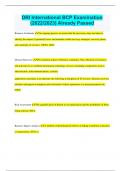Summary
Literature Summary - Internet, Social Media and Networks - Master UU
- Module
- Institution
Literature summary for the course Internet, Social Media and Networks at Utrecht University 2022/2023. This contains the 5 weeks of literature including the book chapters and articles.
[Show more]












